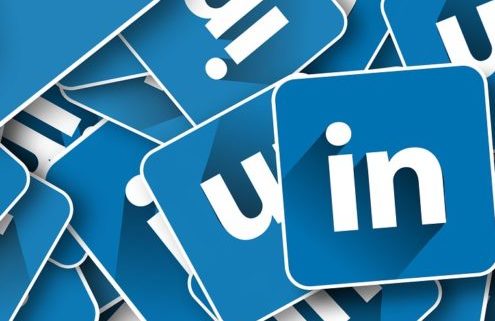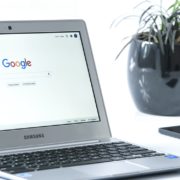What you need to know about LinkedIn Advertising for B2B marketing
The social platform LinkedIn, has over 500 million members, of which 260 million are logging in each month and 40% of active monthly users are using it daily. As a professional platform, the typical LinkedIn user looks for valuable content to read and uses it to make connections with businesses and other professionals. This is in marked contrast to your typical consumer behaviour on social media platforms, like Instagram or Facebook, which involves scrolling through a feed of your friends’ wedding photos, your cousin’s holiday videos and a selection of Buzzfeed quizzes. If you’re a B2B marketer and you’re looking to engage with professionals, you could be reaching millions of them every day through advertising and sharing content on LinkedIn – and the best part is, they’re far more likely to read what you have to offer.
According to recent research, LinkedIn makes up more than 50% of all social traffic to B2B websites and blogs and 92% of B2B marketers use LinkedIn as part of their digital marketing mix. What’s more, out of all B2B leads derived from social media, LinkedIn is responsible for 80%, compared to only 13% coming from Twitter and just 7% from Facebook.
With LinkedIn advertising, you’re targeting a quality audience of professionals, including the 73 million users who are senior-level influencers and 45 million decision makers.
How to set up self-service LinkedIn advertising
There are three main LinkedIn advertising options available through LinkedIn’s self-service advertising platform, Campaign Manager. These are Sponsored Content, Sponsored InMail and Text Ads. To create an ad you will need to have a personal LinkedIn page. You simply sign in to your personal LinkedIn account, click on ‘Work’ in the menu, select ‘Advertise’ and then select ‘Create ad’. This will take you to Campaign Manager, in which you will need to create an account if you do not already have one. Campaign Manager is where you manage your adverts and access dynamic and visual reports of your ads’ performances.
How much does it cost?
You can control the costs of a self-service ad (Sponsored Content, Sponsored InMail, Text Ad) by setting up start and end dates and allocating maximum budgets. Much like Google Ads (as it is now called), you define the costs of these adverts in two ways. First, by setting a maximum daily budget, then by setting a maximum amount you want to pay for each click (CPC) or for every 1,000 impressions (CPM) your ad receives. If you choose the bidding option, Campaign Manager will suggest a bid range based on the current competing bids by other advertisers targeting the same audience. The costs of CPCs and CPMs on LinkedIn are typically more expensive than other social media platforms; however, you would expect the engagement and conversion rates to be higher.
Sponsored Content
Sponsored Content is a form of native advertising that appears directly in the LinkedIn feeds of the professionals you wish to target and works on both desktop and mobile. It is the preferred option for sharing rich content that you want to stand out in the news feeds of your targets and often includes either a link to an interesting article, your company website, a video or an audio clip. The natural placement of this style of advertising typically gets more engagement compared to other LinkedIn advertising methods and enables you to use more text and larger images. In order to create Sponsored Content, you must have a company LinkedIn page, as you will use content that have created or shared via your company page to turn into a sponsored post. You can choose to run your Sponsored Content ads on a cost-per-click (CPC) or cost-per-1,000-impressions (CPM) basis.
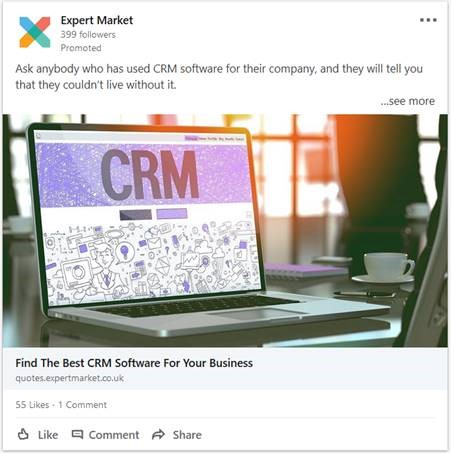
Sponsored InMail
Sponsored InMail is a unique form of advertising that allows you to reach users when they’re most engaged. Through LinkedIn Messenger the Sponsored InMail will send personalised messages to targeted individuals which are only sent when they are active on LinkedIn to help the messages get noticed. It’s an effective form of advertising for sending messages with more text, including personalised invitations to webinars and other events or to promote content such as downloadable e-books and white papers. The ads work on all devices and consist of a custom greeting, call-to-action button, body text and the ability to add links in the text. Sponsored InMail ads run on a “cost per send” basis, meaning that you pay per unit for each message you send.
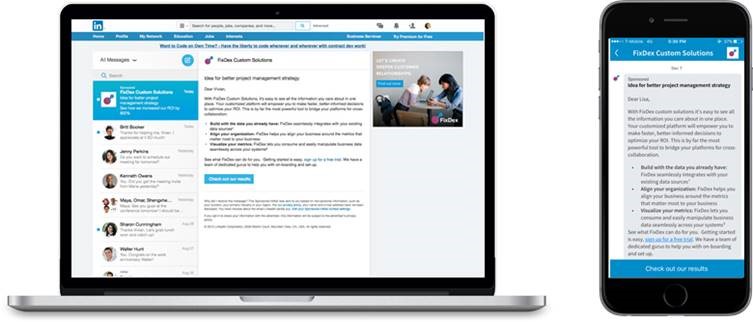
Text Ads
Alternatively, you can create Text Ads which are small, straight to the point and usually appear at the top of the LinkedIn homepage. However, they only show on desktop devices and therefore typically have a lower CPM compared to other LinkedIn ad formats. They consist of a maximum 50 x 50 pixel image, which is usually an image of a product, person or the company logo and sits alongside a maximum 75 character limit copy and 25 character limit headline, therefore the call to action must be short and concise. They are suitable for driving prospects to your company LinkedIn page or to a specific landing page on your website.
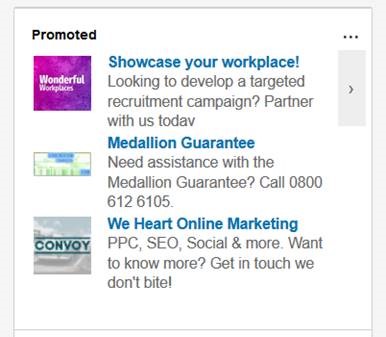
Dynamic Ads
LinkedIn Dynamic Ads are available to purchase through a LinkedIn Marketing Solutions representative. They only appear on desktop devices, on the right-hand side of your home page and use the LinkedIn profile image of the individual you are targeting to attract their attention. Dynamic Ads have a catchy call-to-action such as an invitation to follow a page, join a group or visit a website and there is a small space for a company logo so the prospect can identify who the ad has come from. They are effective for building engagement and followers on your company page by targeting the right prospects based on audience profiling.
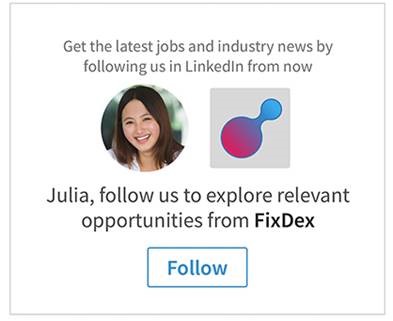
Display Ads
LinkedIn Display Ads are only visible on desktop and can be purchased through your programmatic buying provider, through either an open auction or LinkedIn private auction. There are two options for targeting audiences with Display Ads, the first is ‘intent-based targeting’; which is used to retarget website visitors, CRM contacts, similar audiences or using your own first or third party cookie data. Alternatively, ‘professional identity targeting’ uses LinkedIn’s audience segments to reach professional audiences based on their company size, seniority, career type, education and more. Display Ads are suitable for creating engaging and eye-catching content and reaching audiences on high-traffic LinkedIn pages.
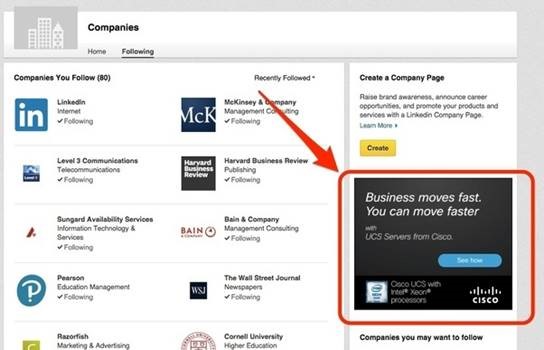
Why B2B marketers should think about using LinkedIn advertising
• Advertising through LinkedIn enables you to target audiences based on their company, job title, seniority, qualifications, age, gender and more. From the perspective of a B2B marketer, it has the potential to generate more focused, high-quality leads and conversions. There is a maximum of 100 selections per targeting option and you can also enable ‘audience expansion’ to increase the reach of your campaigns by showing your ads to audiences with a similar profiling to your selected target audience. Unlike Facebook Ads, LinkedIn allows you to drill down to reach more specific and targeted users based on their professional background.
• You can also test your ad methods by using A/B testing methods or by rotating ad variations to test your ads’ performances over time. You can vary your ads by changing the image, headline, text or destination to see which ad performs best.
• You can measure the success of your ads using the Campaign Manager to track the performance of clicks, impressions, costs and other metrics. The reports also provide a detailed view of the demographic categories of the LinkedIn members who saw and engaged with your ads.
• You are in control. You define what you will pay for each click or 1000 impressions and you won’t pay more than the budget you’ve set.
• Furthermore, a study by HubSpot revealed that LinkedIn generates the highest visitor-to-lead conversion rates (2.74%), compared to Twitter ( 0.69%) and Facebook (0.77%), making it the number one social network for lead generation.
Without a doubt, LinkedIn is the top performing lead generating social platform for B2B marketers. The advertising costs may be a little more expensive than other networks, but with LinkedIn advertising, the stats all show you are likely to get a higher quality and greater volume of leads compared to the likes of Facebook or Twitter. If you are not already utilising LinkedIn advertising, we hope we’ve given you something to think about…

